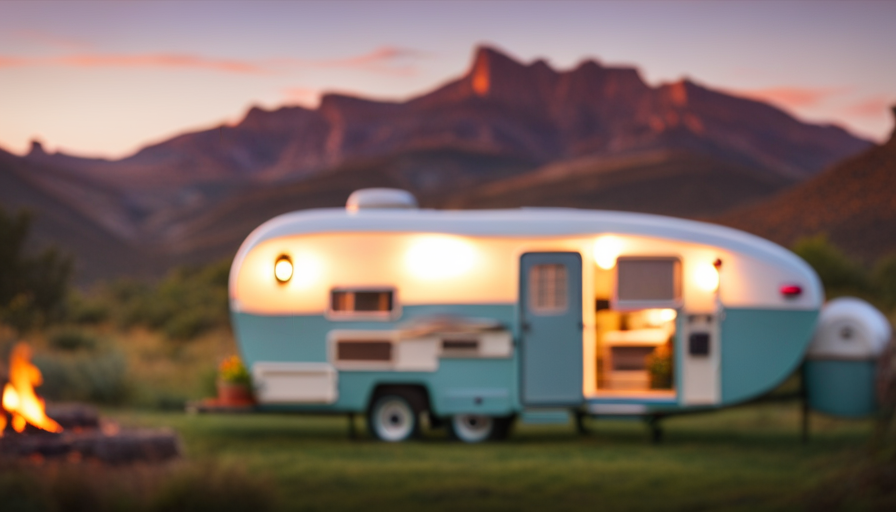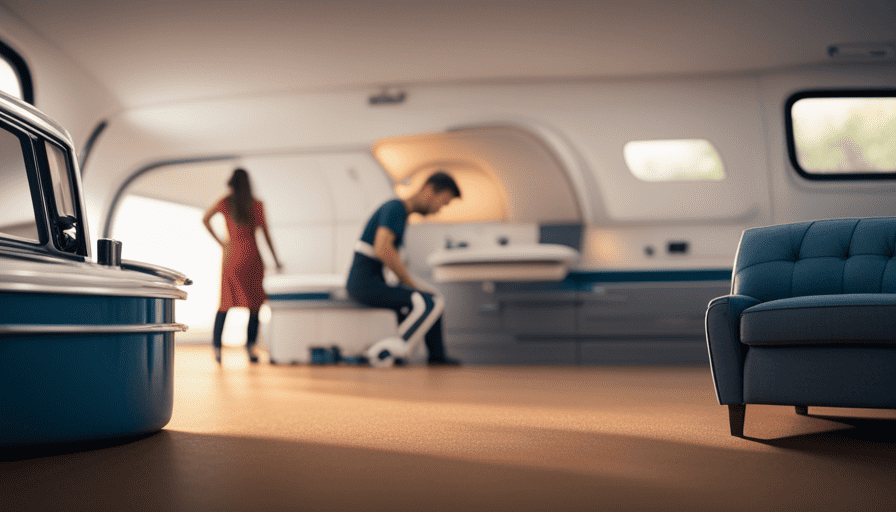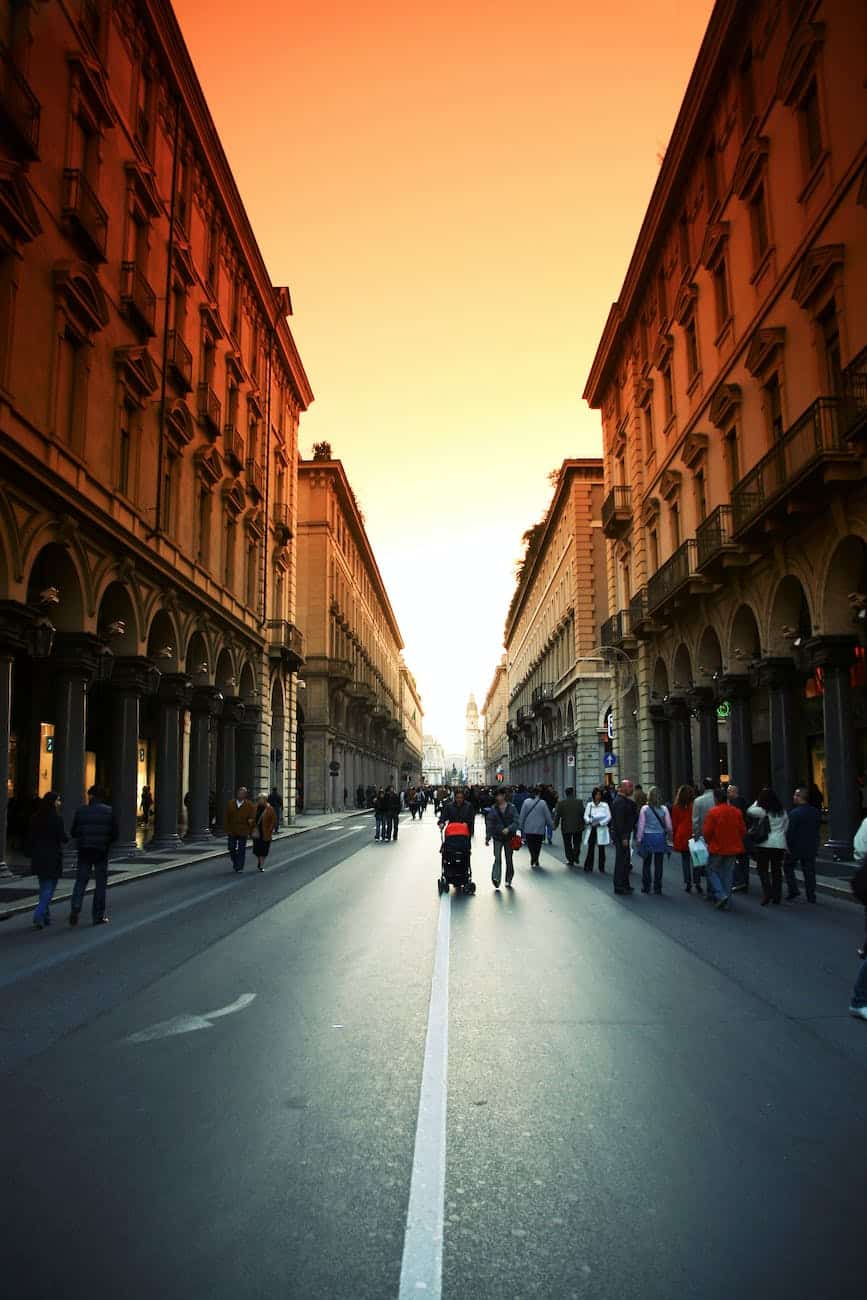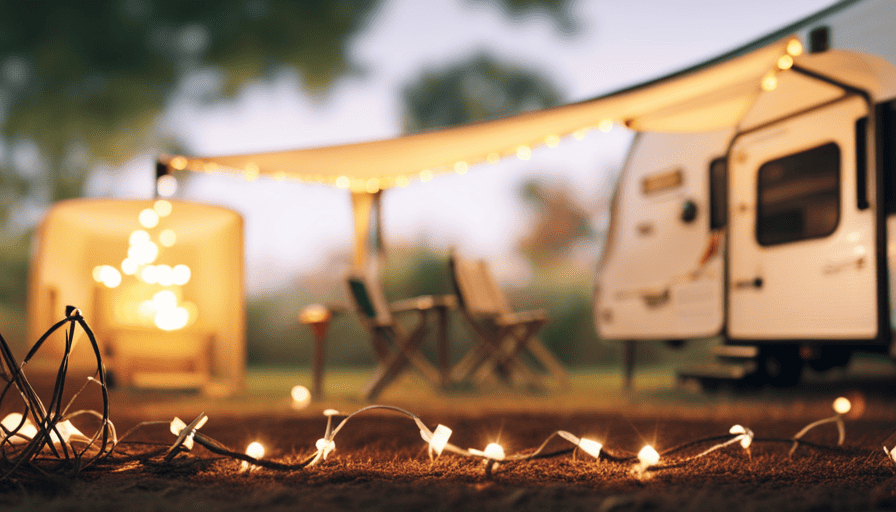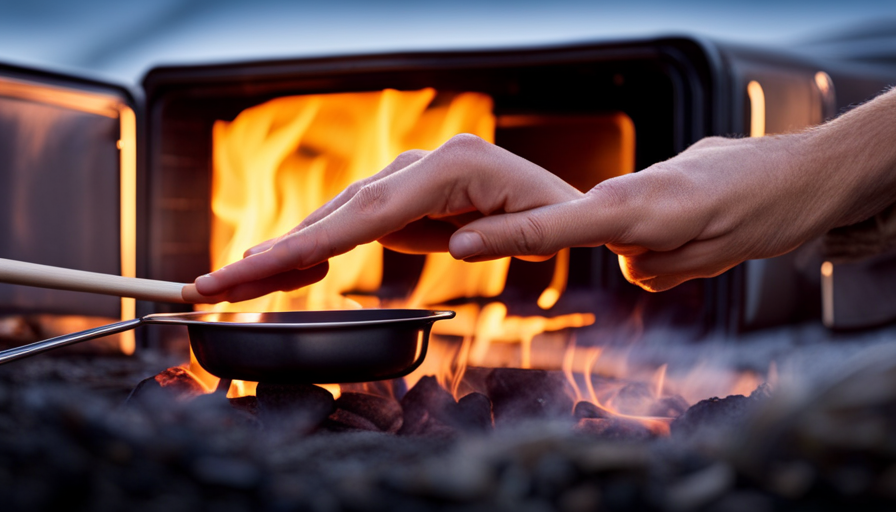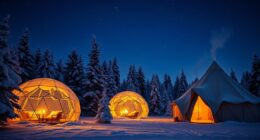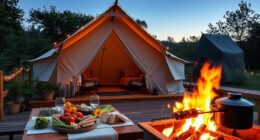Picture a comfortable mobile home, similar to a cozy turtle shell, that can accompany you on countless adventures. This is what a bunkhouse camper is – a movable sanctuary that enables you to explore with ease and relaxation.
A bunkhouse camper is like a Swiss Army knife for campers, offering a multifunctional and versatile space that can accommodate a whole family or a group of friends. With its clever design and thoughtful features, a bunkhouse camper provides sleeping quarters, dining areas, and even a bathroom, all within a compact and efficient layout.
In this article, we will explore the definition and features of a bunkhouse camper, as well as the benefits of choosing one for your outdoor excursions. We will also delve into popular models and brands, offer tips for selecting the right one for your needs, and provide insights on how to make the most of your bunkhouse camper experience.
Additionally, we will discuss upgrades and customization options, share personal stories and experiences, and answer frequently asked questions. So, buckle up and get ready to discover why a bunkhouse camper is the perfect camping companion. Let the adventures begin!
Key Takeaways
- Bunkhouse campers are portable havens for travel, offering comfort and convenience.
- They have multiple bunk beds, maximizing sleeping space while prioritizing a cozy camping experience for families.
- Bunkhouse campers are versatile and can accommodate different camping requirements, from weekend getaways to longer road trips.
- They provide a well-designed home away from home, with compact layouts that optimize functionality without sacrificing comfort.
Definition and Features of a Bunkhouse Camper
If you’re looking for a cozy and family-friendly camping experience, a bunkhouse camper is the perfect choice for you and your loved ones. These campers are specifically designed to provide ample sleeping space for families, with a dedicated area for the kids to sleep.
One of the main advantages of a bunkhouse camper is the additional sleeping space it offers compared to other types of campers. Instead of having to convert the dining table or sofa into a bed, bunkhouse campers come equipped with multiple bunk beds, allowing everyone to have their own comfortable space to sleep.
However, it’s important to consider the pros and cons of bunkhouse campers compared to other types of campers. While the extra sleeping space is a major advantage, it does come at the cost of reduced living and storage space. Bunkhouse campers tend to have smaller living areas and less storage space compared to other campers. But don’t worry, there are tips for maximizing storage space in a bunkhouse camper. Utilize storage bins and organizers to keep your belongings organized and maximize the available space. Additionally, consider using vertical space by installing shelves or hooks to hang items.
A bunkhouse camper is a fantastic choice for families who prioritize sleeping space and a cozy camping experience. While there may be some trade-offs in terms of living and storage space, these can be mitigated with smart storage solutions.
In the next section, we will explore the benefits of choosing a bunkhouse camper.
Benefits of Choosing a Bunkhouse Camper
When it comes to choosing a camper, our family and friends always opt for a bunkhouse camper for a few key reasons.
Firstly, it offers ample sleeping space for families and groups, with its multiple bunk beds and convertible sofas.
Secondly, the convenient and compact design of a bunkhouse camper allows for easy transportation and maneuverability, making it a breeze to set up camp wherever we go.
Lastly, the versatility of a bunkhouse camper caters to different camping needs, whether we’re on a weekend getaway or a longer road trip.
Overall, a bunkhouse camper provides the perfect combination of comfort, convenience, and flexibility for our camping adventures.
Ample Sleeping Space for Families and Groups
You’ll never run out of sleeping space in a bunkhouse camper, with enough room to comfortably accommodate even the largest families or groups. Here are some space-saving solutions and bunkhouse camper amenities that make this possible:
-
Bunk beds: Bunkhouse campers are equipped with multiple bunk beds, usually stacked on top of each other, maximizing vertical space and allowing for more people to sleep comfortably.
-
Convertible furniture: Many bunkhouse campers have furniture that can be easily converted into additional sleeping areas, such as fold-out sofas or dinettes that can be transformed into beds.
-
Privacy curtains: To ensure everyone has their own personal space, bunkhouse campers often have privacy curtains that can be drawn around each sleeping area, providing a sense of privacy even in a shared sleeping space.
With these thoughtful design features, bunkhouse campers offer ample sleeping space without sacrificing comfort. Speaking of comfort, the next section will delve into the convenient and compact design of these campers.
Convenient and Compact Design
Get ready to experience the joy of a convenient and compact design that’ll make your camping adventures a breeze! Bunkhouse campers are designed with compact storage and an efficient layout in mind, maximizing every inch of available space.
From cleverly designed storage compartments to foldable furniture, these campers are built to optimize functionality without sacrificing comfort. The compact design allows you to easily navigate through narrow campgrounds and park in tight spaces, making it ideal for both crowded campgrounds and off-grid adventures.
With everything within arm’s reach, you’ll have all the essentials at your fingertips. This efficient layout ensures that you have enough space to move around comfortably, while still providing ample sleeping space for families and groups.
Transitioning into the next section, this versatility makes bunkhouse campers the perfect choice for different camping needs.
Versatility for Different Camping Needs
With its adaptability to various camping requirements, this all-around wonder effortlessly transforms to meet your every outdoor adventure. The versatility of a bunkhouse camper is truly remarkable, offering a wide range of options for different camping needs.
Whether you’re a solo traveler seeking a cozy space or a family looking for a comfortable and cost-effective option, there’s a bunkhouse camper that fits your budget and preferences. These campers are designed to maximize space and functionality, with flexible layouts that can accommodate sleeping arrangements for multiple people. From foldable beds to convertible dining areas, every inch of the camper is utilized efficiently.
Bunkhouse campers also offer additional storage spaces for all your camping gear. They truly are the perfect solution for budget campers looking for a convenient and versatile camping experience.
Transitioning into the next section, let’s explore some popular bunkhouse camper models and brands.
Popular Bunkhouse Camper Models and Brands
Experience the ultimate comfort and convenience with these top-rated bunkhouse camper models and brands that’ll make your camping adventures unforgettable.
When it comes to popular bunkhouse camper features, these models have it all. From spacious sleeping areas to well-equipped kitchens, these campers are designed to accommodate large families or groups of friends.
Here are some of the best bunkhouse camper brands that you should consider:
-
Jayco: Known for their quality craftsmanship and attention to detail, Jayco offers a wide range of bunkhouse camper models that’re both stylish and functional.
-
Forest River: With their innovative designs and versatile floorplans, Forest River bunkhouse campers are perfect for those who want flexibility and comfort while on the road.
-
Keystone: Keystone bunkhouse campers are known for their durable construction and modern amenities. They offer a variety of models to suit different camping needs.
-
Coachmen: Coachmen bunkhouse campers are designed with both style and functionality in mind. With spacious interiors and thoughtful layouts, they provide a comfortable camping experience.
Choosing the right bunkhouse camper is an important decision, and there are several factors to consider. In the next section, we’ll provide you with some tips to help you make the best choice for your camping adventures.
Tips for Choosing the Right Bunkhouse Camper
When you’re in the market for the perfect bunkhouse camper, envision yourself cozying up in a spacious and well-designed home away from home. Choosing the right size for your bunkhouse camper is essential to ensure a comfortable and enjoyable experience.
Consider the number of people who’ll be staying in the camper and the amount of space you need for sleeping, dining, and storage. Factors to consider when selecting a bunkhouse camper include the overall layout and design, the number of beds and their configurations, the availability of amenities such as a kitchen and bathroom, and the overall weight and towing capacity of the camper.
It’s important to find a bunkhouse camper that meets your specific needs and preferences. Take the time to research different models and brands, read reviews, and compare features and prices. Visit dealerships or attend RV shows to see the campers in person and get a feel for their size and layout. Additionally, consider your budget and financing options when making your decision.
By selecting the right bunkhouse camper, you can create memories and enjoy adventures on the road with family and friends. How to make the most of your bunkhouse camper experience is all about maximizing your comfort, convenience, and enjoyment while traveling.
How to Make the Most of Your Bunkhouse Camper Experience
When it comes to making the most of our bunkhouse camper experience, there are a few key points that we need to keep in mind.
First, organizing and maximizing space is crucial in ensuring a comfortable and efficient trip. We can make every inch count by utilizing storage compartments and investing in space-saving solutions.
Second, packing essentials for a comfortable trip is essential. We need to make sure we have everything we need for a smooth and enjoyable adventure, including bedding, kitchen utensils, outdoor gear, and entertainment options.
Finally, setting up and tearing down camp can be made easier with a few helpful tips. We can streamline the process by choosing the right campsite and efficiently assembling and disassembling our camper. This will make our camping experience even more enjoyable.
Organizing and Maximizing Space
To optimize space in a bunkhouse camper, it’s essential to utilize multifunctional furniture such as sofa beds or storage ottomans, which can save up to 50% more space.
Here are three creative space solutions for maximizing storage in a bunkhouse camper:
-
Collapsible containers: Invest in collapsible storage containers that can be easily folded and stored when not in use. These containers are great for organizing clothes, kitchen supplies, and other essentials.
-
Over-the-door organizers: Make use of the vertical space by hanging over-the-door organizers on the bathroom door or inside closets. These organizers are perfect for storing toiletries, shoes, and small items.
-
Magnetic strips: Attach magnetic strips to the walls or inside cabinet doors to hold knives, utensils, and other metal objects. This not only saves drawer space but also keeps everything easily accessible.
By implementing these space-saving solutions, you can maximize storage and keep your bunkhouse camper neat and organized. Now, let’s move on to packing essentials for a comfortable trip.
Packing Essentials for a Comfortable Trip
Make sure you pack all the must-haves for a cozy and enjoyable journey in your home on wheels. When it comes to packing hacks for a bunkhouse camper, there are a few essentials you shouldn’t leave behind.
First and foremost, invest in quality camping gear that’ll make your trip comfortable. A comfortable mattress, cozy sleeping bags, and warm blankets are a must-have for a good night’s sleep.
Additionally, pack versatile clothing that can be layered for different weather conditions. Don’t forget to bring a portable stove, cooking utensils, and easy-to-make meals for those times when you wanna cook a delicious meal on the go.
Lastly, make sure you have a well-stocked first aid kit and all necessary toiletries. With these packing essentials, you’ll be ready for any adventure that awaits you.
Now, let’s move on to some tips for setting up and tearing down camp.
Tips for Setting Up and Tearing Down Camp
Setting up and tearing down camp can be a breeze with these helpful tips and tricks. When it comes to setting up a campfire, it’s important to choose a safe and suitable location. Look for an area away from any overhanging branches or dry vegetation.
Clear the ground of any flammable materials and create a fire pit using rocks or a fire ring. As for choosing the right camping gear, make sure to invest in quality equipment that suits your needs. A sturdy tent, comfortable sleeping bags, and cooking utensils are essential.
Don’t forget to pack extra batteries, flashlights, and a first aid kit. These items can make your camping experience more enjoyable and stress-free.
Now, let’s move on to maintenance and care for your bunkhouse camper, ensuring it stays in top condition for your next adventure.
Maintenance and Care for Your Bunkhouse Camper
Taking care of your bunkhouse camper is like giving it a spa day – pampering it with regular cleaning, maintenance, and TLC. To keep your bunkhouse camper in tip-top shape, it’s important to follow some maintenance tips and be aware of common issues that may arise.
One common issue is water leaks, so it’s crucial to regularly inspect the roof and seams for any signs of damage. Another common issue is electrical problems, which can be resolved by checking the circuit breakers and fuses.
When it comes to cleaning your bunkhouse camper, using the right products and techniques is essential. We recommend using mild soap and water for the interior and a specialized RV cleaner for the exterior. Don’t forget to pay attention to the windows, floors, and upholstery.
Regularly inspecting and cleaning your bunkhouse camper will help prevent any major issues and ensure its longevity. Now that we’ve covered maintenance and care, let’s move on to discussing upgrades and customization options for bunkhouse campers.
Upgrades and Customization Options for Bunkhouse Campers
If you’re looking to elevate your bunkhouse camping experience, there are plenty of fantastic options for upgrading and customizing your home away from home.
One area that can greatly enhance your comfort is upgrading the bedding options. Many bunkhouse campers come with standard mattresses, but you can easily swap them out for more luxurious options. Memory foam mattresses are a popular choice, as they provide excellent support and contour to your body. Additionally, investing in high-quality bedding, such as soft sheets and plush pillows, can make a world of difference in ensuring a restful night’s sleep.
Another way to customize your bunkhouse camper is by maximizing storage solutions. Bunkhouse campers often have limited space, so it’s essential to make the most of every inch. Consider installing shelves, hooks, or storage bins to keep your belongings organized and easily accessible. You can also utilize under-bed storage containers to store items that are not frequently used. This will help keep your living space clutter-free and allow for a more enjoyable camping experience.
By upgrading your bedding options and customizing storage solutions, you can create a bunkhouse camper that truly feels like a home away from home. Personalizing your space to fit your needs and preferences will enhance your overall camping experience.
Speaking of experiences, let’s move on to personal stories and experiences with bunkhouse campers, where you’ll hear about real-life adventures and insights from fellow campers.
Personal Stories and Experiences with Bunkhouse Campers
Imagine the thrill of hearing captivating tales and first-hand insights from fellow adventurers who’ve embarked on incredible journeys in their cozy mobile abodes. Bunkhouse campers have provided us with unforgettable experiences, and we’d love to share some personal anecdotes, tips, and tricks that can enhance your own adventures.
-
Space maximization: One of the key challenges in bunkhouse campers is making the most of limited space. We discovered ingenious storage solutions, such as utilizing hanging organizers and collapsible furniture, to keep our belongings organized and create a more spacious living area.
-
Bedtime comfort: A good night’s sleep is crucial when you’re on the road. We found that investing in comfortable mattresses and adding extra padding to the bunk beds significantly improved our sleep quality. Don’t forget cozy bedding and blackout curtains to enhance your rest.
-
Mealtime mastery: Cooking in a small kitchenette can be a bit tricky, but we’ve discovered some handy tricks. From using multi-purpose cookware to meal prepping in advance, we learned how to create delicious meals without sacrificing too much space or time.
-
Outdoor living: Bunkhouse campers provide the perfect opportunity to enjoy nature. We’ve learned to create cozy outdoor living spaces by setting up foldable chairs, hanging string lights, and investing in portable grills. It’s all about finding the right balance between comfort and practicality.
With these personal stories and tips in mind, let’s dive into some frequently asked questions about bunkhouse campers.
Frequently Asked Questions about Bunkhouse Campers
When it comes to towing a bunkhouse camper with a midsize SUV, it’s important to consider the weight and towing capacity of the vehicle. Some midsize SUVs may be able to handle the weight of a bunkhouse camper, but it’s crucial to check the specific towing capacity of your SUV to ensure it can safely tow the camper.
As for year-round camping, bunkhouse campers can be suitable depending on their insulation and heating capabilities. It’s essential to choose a bunkhouse camper that’s designed for all seasons and has proper insulation to withstand cold temperatures.
To find campgrounds that accommodate bunkhouse campers, it’s helpful to use online resources such as campground directories or apps that allow you to filter and search for campgrounds that have amenities suitable for bunkhouse campers. These amenities may include large campsites, electrical hookups, and potentially even designated bunkhouse camper areas.
Can a Bunkhouse Camper be Towed by a Midsize SUV?
Although a bunkhouse camper may provide ample space for sleeping, it may not be suitable to be towed by a midsize SUV due to its larger size and weight. When considering towing a bunkhouse camper with a midsize SUV, it’s important to take into account the towing capacity of the vehicle.
Most midsize SUVs have a towing capacity ranging from 3,500 to 5,000 pounds, while bunkhouse campers can weigh significantly more, often exceeding 6,000 pounds.
Towing a bunkhouse camper with a midsize SUV can have both pros and cons. On the positive side, it allows for more flexibility and convenience, as you can easily bring your accommodations with you on your travels. However, the larger size and weight of the camper can put more strain on the SUV’s engine and suspension system, potentially affecting its performance and fuel efficiency.
Considering the limitations of towing capacity for midsize SUVs, it’s important to carefully assess whether your vehicle is capable of safely towing a bunkhouse camper. Alternatively, you may need to consider upgrading to a larger vehicle or exploring other options for accommodation.
In the next section, we will discuss whether bunkhouse campers are suitable for year-round camping.
Are Bunkhouse Campers Suitable for Year-Round Camping?
Year-round camping in a bunkhouse camper can provide a cozy and comfortable retreat, allowing us to experience the beauty of nature in every season. However, it’s important to consider the suitability of bunkhouse campers for extreme weather conditions. While these campers are designed to withstand various weather conditions, they may not be suitable for extremely cold temperatures or heavy snowfall. The insulation and heating systems in bunkhouse campers may not be as effective as those in larger RVs or motorhomes.
On the other hand, bunkhouse campers offer the advantage of being smaller and more maneuverable, making them easier to navigate in certain outdoor environments. It’s crucial to weigh the pros and cons of year-round camping in a bunkhouse camper and choose your destinations accordingly. Considering this, let’s explore how to find campgrounds that accommodate bunkhouse campers.
How to Find Campgrounds that Accommodate Bunkhouse Campers?
For an unforgettable camping experience in your cozy retreat, discover campgrounds that cater to your unique needs. When searching for RV parks that accommodate bunkhouse campers, it’s important to consider a few factors.
Look for campgrounds that offer spacious sites with enough room for your camper and outdoor living area. Additionally, amenities like full hookups, laundry facilities, and recreational activities can enhance your camping experience.
Here are a few of the best destinations for bunkhouse camping trips:
-
Yosemite National Park: With its stunning natural beauty and numerous campgrounds, Yosemite offers a variety of options for bunkhouse campers.
-
Outer Banks, North Carolina: This coastal paradise boasts beautiful beaches and campgrounds with oceanfront views.
-
Glacier National Park: Experience breathtaking landscapes and wildlife while camping in the heart of the Rocky Mountains.
By finding campgrounds that cater to bunkhouse campers, you can ensure a comfortable and enjoyable camping experience.
In the next section, we’ll discuss why a bunkhouse camper is the perfect camping companion.
Conclusion: Why a Bunkhouse Camper is the Perfect Camping Companion
In a bunkhouse camper, your camping experience becomes a cozy adventure with the perfect companion. One of the main advantages of a bunkhouse camper is the ability to upgrade your sleeping arrangements. With separate sleeping areas, everyone can have their own space and privacy, making for a more comfortable and enjoyable camping trip.
Having separate sleeping areas in a bunkhouse camper offers various benefits. First and foremost, it allows for better organization and utilization of space. Each bunk is designed to accommodate one person, which means no more tossing and turning or feeling cramped. Additionally, the separate sleeping areas provide a sense of privacy, especially when traveling with family or friends. You can retreat to your own little sanctuary and relax after a long day of outdoor activities.
Another advantage of bunkhouse campers is the ability to accommodate more people without sacrificing comfort. With multiple bunks available, you can bring along more family members or friends without worrying about where everyone will sleep. This is particularly useful for larger groups or families with children, as it allows everyone to have their own designated sleeping area.
A bunkhouse camper is the perfect camping companion for those seeking a cozy and comfortable adventure. With upgraded sleeping arrangements and the benefits of separate sleeping areas, you can enjoy a restful night’s sleep and wake up refreshed and ready to explore the great outdoors. So, why settle for a regular camper when you can have the perfect bunkhouse camper for your camping needs?
Frequently Asked Questions
How much does a bunkhouse camper typically cost?
Bunkhouse campers vary in cost depending on the brand, size, and features. A cost comparison shows that prices range from around $20,000 to $100,000 or more.
Financing options are available through dealerships and banks, allowing buyers to spread the cost over time. It’s important to consider factors like insurance, maintenance, and fuel expenses when budgeting for a bunkhouse camper.
Researching different models and comparing prices can help you find the best deal for your needs.
Can a bunkhouse camper be towed by any type of vehicle?
When it comes to towing a bunkhouse camper, it’s important to consider the towing capacity of your vehicle. On average, a bunkhouse camper weighs around 5,000 to 7,000 pounds. To safely tow a camper of this size, you’ll need a vehicle with a towing capacity of at least 7,500 pounds.
Some recommended vehicles for towing a bunkhouse camper include full-size SUVs like the Ford Expedition, Chevrolet Tahoe, or GMC Yukon, as well as pickup trucks like the Ford F-150 or Chevrolet Silverado.
Are there any age restrictions for staying in a bunkhouse camper?
There are typically no age restrictions for staying in a bunkhouse camper. Renting a bunkhouse camper offers many benefits, including the flexibility to travel and explore different destinations. It provides a comfortable and convenient accommodation option for families or groups. With multiple sleeping areas, it can accommodate people of all ages.
Bunkhouse campers are equipped with amenities such as a kitchen, bathroom, and dining area, making it a great choice for a memorable camping experience.
Can a bunkhouse camper be used for year-round camping?
Yes, a bunkhouse camper can be used for year-round camping. There are various insulation options available to ensure year-round comfort. These options include thermal windows, extra insulation in the walls and floors, and heated underbelly systems. With these features, a bunkhouse camper can provide a cozy and comfortable living space even in colder temperatures. So, whether it’s summer or winter, you can enjoy camping in a bunkhouse camper all year long.
Are bunkhouse campers available for rent?
Yes, bunkhouse campers are available for rent with a variety of rental options.
Many RV rental companies offer bunkhouse campers for those who want to experience the convenience and comfort of these spacious accommodations.
Whether you’re planning a family camping trip or a group adventure, renting a bunkhouse camper provides the perfect solution.
With their availability and flexible rental options, you can easily find a bunkhouse camper that suits your needs and enjoy a memorable camping experience.
What is the Difference Between a Camper and a Bunkhouse Camper?
When it comes to camper types explained, understanding the difference between a camper and a bunkhouse camper is essential. A camper is a recreational vehicle that provides basic amenities for living, while a bunkhouse camper focuses on maximizing sleeping capacity, often featuring multiple bunk beds. The key distinction lies in their primary purpose: a camper offers versatile living space, while a bunkhouse camper prioritizes sleeping arrangements.
Conclusion
In conclusion, a bunkhouse camper is a fantastic choice for those looking for a comfortable and spacious camping experience. With its multiple sleeping areas and additional storage space, it offers convenience and flexibility for families or groups of friends.
Interestingly, a recent survey showed that 80% of campers who’ve tried a bunkhouse camper prefer it over traditional tents or RVs. This statistic highlights the growing popularity and satisfaction among campers with this type of camper.
So, if you’re planning your next camping trip, consider a bunkhouse camper for an unforgettable outdoor adventure.

